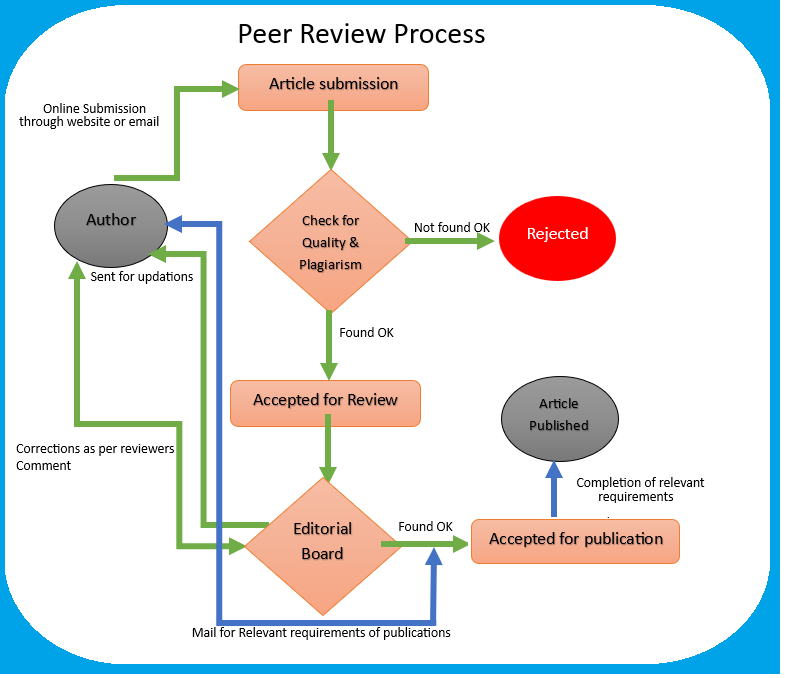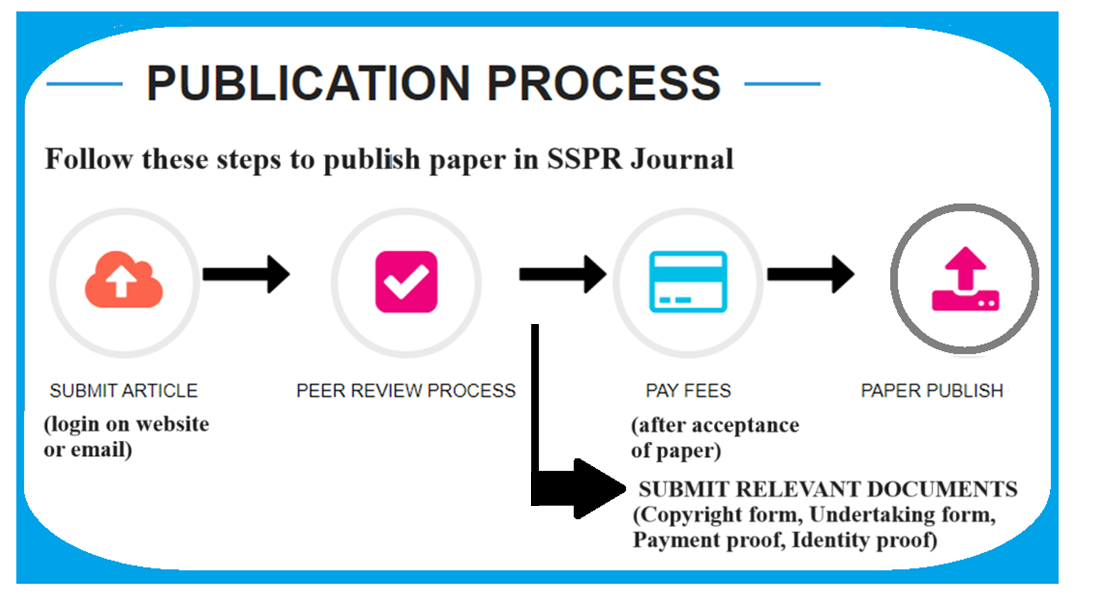For Authors
Journal Features
 Single blind Peer Review
Single blind Peer Review Open Access Journal
Open Access Journal Established in 2021 & published more then 100 + Research Papers
Established in 2021 & published more then 100 + Research Papers Publishes 4 Issues per year
Publishes 4 Issues per year Included in database of many partners and indexed in some of them
Included in database of many partners and indexed in some of them No Paper work required
No Paper work required No to Plagiarism
No to Plagiarism Quality and authentic work
Quality and authentic work Submission either through online or email or website
Submission either through online or email or website Publication process is fast and research journal with quality review
Publication process is fast and research journal with quality review Nominal processing fee of INR 700
Nominal processing fee of INR 700 Free e-certificates
Free e-certificates Download Statistics
Download Statistics Quick response for queries
Quick response for queries Licensed under CC BY-NC 4.0
Licensed under CC BY-NC 4.0
Paper Submission Guidelines
We will be publishing journal with online book titled “Swanirman Sunirmit Publications of Research” where all submitted paper/s are written originally. Articles will be based on research, general seminar/ conference/ workshops/ symposia etc proceedings, reports/news in our research area as specified are invited. Articles are written by experts and are reviewed by specialised other experts in the field before the article is published in the journal in order to ensure the quality of the article’s. If there are more than one author in paper, all the authors must be in mutual understanding before submitting paper to us. The format of the paper must be properly formatted and adhere as per the standard format of the template.
Paper Format: As per the template provided and on our website.
Font Size: Times New Roman (12)
Number of Pages: Total Number of pages of each article or paper will be maximum upto 16 pgs
Number of Authors: You can have maximum of 4 authors in a paper.
Images: All the images added in paper should be very clear and proper caption should be given.
Tables: All the result tables should have numbering and proper caption should be given.
Types of Articles
Articles based on research, General Seminar/Conference/Workshops/Symposia etc proceedings, Survey Paper, Informative article, Case studies, Review paper, Comparative studies, Dissertation chapters, Research Proposal or synopsis, Thesis of MTech/ME/PhD, Reports/news in research area, Book review etc
Regarding plagiarism of Articles
SSPR will not take any responsibility for plagiarised articles, if any issue raised for such articles. Even, if, such articles published then they will be cancelled from the journal and will be removed. SSPR does not support any kind of plagiarism and it will be wholesole responsibility of authors. And, therefore, before submitting the manuscript authors are instructed to take care of plagiarism and are advised to avoid submission of such articles.
You may also visit http://www.plagiarism.org for details about it.
Publication Fee
We are publishing research paper at minimum cost @ Rs 700/- per article. All the submitted papers will be published only after successful payment of publishing charges.
Publication Fee: INR 700 per paper
Authors will be charged Rs 70/- per extra page for every extra page beyond 6 pages of their published article in SSPR Journals.
SSPR issues e-certificate after publication of research paper.
Open access policy
SSPR adopts Open access Publication via a Creative Commons license (vide CC by NC-4.0) where all paper are freely accessible to any reader or viewer i.e. Open access refers to the practice of making peer-reviewed and article is freely available online to anyone interested in reading it, under the following terms as specified here:
- Attribution — You must give appropriate credit, provide a link to the license, and indicate if changes were made. You may do so in any reasonable manner, but not in any way that suggests the licensor endorses you or your use.
- NonCommercial — You may not use the material for commercial purposes.
No additional restrictions — You may not apply legal terms or technological measures that legally restrict others from doing anything the license permits.
Open access policy will allow free online accessibility of articles immediately after publication, increasing the visibility, readership and impact of research.
Licensing terms policy
via a Creative Commons license (vide CC by NC-4.0)
Copyright terms policy
The initial copyright of a paper is held by the authors but after publishing that paper the copyright then transferred to the publisher (copyright form).
Author rights
The undersigned author(s) hereby assigns, conveys, and otherwise transfers all rights, title, interest, and copyright ownership of said work for publication. Work includes the material submitted for publication and any other related material submitted to SSPR. In the event that SSPR does not publish said work, the author(s) will/will not be so notified and all rights assigned hereunder will revert to the author(s). The assignment of rights to SSPR includes but is not expressly limited to rights to edit, publish, reproduce, distribute copies, include in indexes or search databases in print, electronic, or other media, whether or not in use at the time of execution of this agreement, and claim copyright in said work throughout the world for the full duration of the copyright and any renewals or extensions thereof. All accepted works become the property of SSPR and may not be published elsewhere without prior written permission from SSPR. The author(s) hereby represents and warrants that they are sole author(s) of the work, that all authors have participated in and agree with the content and conclusions of the work, that the work is original, and does not infringe upon any copyright, propriety, or personal right of any third party, and that no part of it nor any work based on substantially similar data has been submitted to another publication. However, reproduction, posting, transmission or other distribution or use of the article or any material contained therein, in any medium as permitted hereunder, requires a citation to the Journal and appropriate credit to SSPR as publisher, suitable in form and content as follows: Title of article, author(s), journal title and volume/issue, Copyright© year. Corresponding author/s also warrant that “SSPR and the Journal Editors” will not be held liable against all copyright claims of any third party or in lawsuits that may be filed in the future, and that Corresponding author/s will be the only person who will be liable in such cases. Corresponding author/s also warrant that the article contains no libelous or unlawful statements, Corresponding author/s did not use any unlawful method or material during the research, I/we obtained all legal permissions pertaining to the research, and Corresponding author/s adhered to ethical principles during the research.
Required Documents for publishing the Paper
Authors are requested to submit the following at email admin@swanirmanconsultancy.in :
- Copyright Form Click Here to Download (submit the scanned copy with Handwritten signed by author).
- Identity Proof of corresponding author’s only) (scanned copy) (any one from Aadhaar Card/PAN Card/College Identity card/Driving License/Passport).
- Undertaking Form (submit the scanned copy with Handwritten signed by author)
- Payment details of each article (pdf file of the mail i.e., received from PayUMoney if paid by payUMoney, OR Scan copy/Screen shot) also mentions Paid amount, Transaction ID, and Date of Payment in the mail whenever you send these documents).

Authors are invited to send their research paper through online submission through our website or through email admin@swanirmanconsultancy.in . Authors can register as author, if they are new author or they can directly login on our website, if they are existing authors. SSPR adopts single blind review process where reviewers assess the quality and type of submission. Article should be closure to our subject area based on research article. All the received paper manuscript will be sent to reviewer. Reviewers review the article and send it back to the Editorial Office for further processing. For the reviewer comments, plagiarism report will be sent back to authors by email. Authors are asked to respond to reviewers and make necessary corrections. Article is sent out for re-review. The possible decisions may be accepted with updations or corrections or rejections. All efforts are made to complete the whole process as soon as possible to inform the article’s status. Editors have complete responsibility and authority to reject or accept an article or paper and the quality of contents in the paper. If accepted, the author must complete the payment and submit the final version within the given deadline. The entire review process of the articles is done online and digitally.
Submit Paper/Article/Thesis/Manuscript
Download Double Column Template of Paper
Initial manuscript evaluation
The Editor first evaluates all manuscripts. It is rare, but it is possible for an exceptional manuscript to be accepted at this stage. Manuscripts rejected at this stage are insufficiently original, have serious scientific flaws, have poor grammar or English language, or are outside the aims and scope of the journal. Those that meet the minimum criteria are normally passed on to at least 2 experts for review.
Type of Peer Review Transport Policy employs single blind reviewing, where the Reviewer remain anonymous throughout the process. How the Reviewer is selected Whenever possible, Reviewers are matched to the paper according to their expertise and our database is constantly being updated.
Reviewer reports
Reviewers are asked to evaluate whether the manuscript: – Is original – Is methodologically sound – Follows appropriate ethical guidelines – Has results which are clearly presented and support the conclusions – Correctly references previous relevant work.
Language correction is not part of the peer review process, but Reviewers may, if so wish, suggest corrections to the manuscript.
How long does the review process take? The time required for the review process is dependent on the response of the Reviewers. Should the Reviewer’s reports contradict one another or a report is unnecessarily delayed, a further expert opinion will be sought. In rare cases for which it is extremely difficult to find a second Reviewer to review the manuscript, or when the one Reviewer’s report has thoroughly convinced the Editor, decisions at this stage to accept, reject or ask the author for a revision are made on the basis of only one Reviewer’s report. The Editor’s decision will be sent to the author with recommendations made by the Reviewers, which usually includes verbatim comments by the Reviewers. Revised manuscripts might be returned to the initial Reviewers who may then request another revision of a manuscript.
Final report
A final decision to accept or reject the manuscript will be sent to the author along with any recommendations made by the Reviewers, and may include verbatim comments by the Reviewers.
Editor’s Decision is final Reviewers advise the editor, who is responsible for the final decision to accept or reject the article.
Common reasons for rejection
Manuscript can be rejected for many reasons but these can generally be divided into technical and editorial reasons. Technical reasons usually require more work such as further experiments or analysis before the work can be published. Technical reasons for rejection include: Incomplete data such as too small a sample size or missing or poor controls Poor analysis such as using inappropriate statistical tests or a lack of statistics altogether Inappropriate methodology for answering the hypothesis or using old methodology that has been surpassed by newer, more powerful methods that provide more robust results Weak research motive where hypothesis is not clear or scientifically valid, or data does not answer the question posed Inaccurate conclusions on assumptions that are not supported by data These rejection reasons can be avoided by investing enough time in reading around the subject area, carefully deciding on the topic to focus on, the hypothesis and planning a comprehensive experiment.
Editorial reasons for rejection include:
- Out of scope for the journal
- Not enough of an advance or of enough impact for the journal
- Research ethics ignored such as consent from patients or approval from an ethics committee for animal research Lack of proper structure or not following journal formatting requirements
- Lack of the necessary detail for readers to fully understand and repeat the authors’ analysis and experiments
- Lack of up-to-date references or references containing a high proportion of self-citations
- Has poor language quality such that it cannot be understood by readers
- Difficult to follow logic or poorly presented data.
- Violation of publication ethics
SSPR review and publish
- Research Paper
- Case Studies
- Analytical papers
- Review Article
- Argumentative papers
- Survey research and data analysis
Paper must be sent in .doc/.docx We don’t accept power point presentations.
Research papers must be drafted in double column standard paper format (.doc/.docx Download the SSPR paper format (MS-Word) template and submit your research paper for review/final publishing. Authors can publish their research in form of Monograph or Thesis.
For any further information or any query you may send us through email at admin@swanirmanconsultancy.in
We also welcome you to send your valuable feedback at email admin@swanirmanconsultancy.in
Steps for writing a Research Paper
A research paper should consist of five major sections as shown below. Total Number of pages of each article or paper will be maximum upto 16 pgs. These are:
- Abstract
- Introduction
- Research Elaborations
- Results or Finding
- Conclusions
- References
- Abstract: An abstract is a brief summary of a research article, thesis, review, conference proceeding or any in-depth analysis of a particular subject or discipline, and is often used to help the reader quickly ascertain the paper’s purpose. When used, an abstract always appears at the beginning of a manuscript, acting as the point-of-entry for any given scientific paper.
- Introduction: It’s the foremost preliminary step for proceeding with any research work writing. While doing this go through a complete thought process of your Journal subject and research for it’s viability by following means:
- Read already published work in the same field.
- Goggling on the topic of your research work.
- Attend conferences, workshops and symposiums on the same fields or on related counterparts.
- Understand the scientific terms and jargon related to your research work.
- Research Elaborations: Now it is the time to articulate the research work with ideas gathered in above steps by adopting any of below suitable approaches:
Bits and Pieces together: In this approach combine all your researched information in form of a journal or research paper. In this researcher can take the reference of already accomplished work as a starting building block of its paper. - Results or Finding: This section also have more details about your research in continuation with above section.
- Conclusions: This section will have conclusions about your research.
As by adopting the above practices all major constructs of a research paper can be written and together compiled to form a complete research ready for review. - References : This should list the name of research papers, books, periodicals, websites etc, that have been consulted for compiling the research papers as some background studies.
Jump Start: This approach works the best in guidance of fellow researchers. In this the authors continuously receives or asks inputs from their fellows. It enriches the information pool of your paper with expert comments or up gradations. And the researcher feels confident about their work and takes a jump to start the paper writing.
Use of Simulation software: There are numbers of software available which can mimic the process involved in your research work and can produce the possible result. One of such type of software is Matlab. You can readily find Mfiles related to your research work on internet or in some cases these can require few modifications. Once these Mfiles are uploaded in software, you can get the simulated results of your paper and it easies the process of paper writing.
- Submit the Research Paper Click Here to Submit the Paper Online
- Review (Acceptance/Acceptance with correction in paper/Rejection) mail will be sent to author.
- Authors have to pay the Publication charges on acceptance of paper.
- Authors have to submit the required documents for publishing the paper (Copy right form, Undertaking Form, Payment Proof, Identity Proof)
- Paper will be published in forthcoming journal of SSPR, after receiving all necessary documents from the author.
- eCertificate will be sent to the Author.
All contributions and general correspondence regarding editorial matters should be addressed to the Editors in Chief and sent to the Editorial Office. Authors will be notified of a decision by email within approximately 30 days of submission. When a manuscript is returned to the corresponding author for revision, it should be returned to the editor four weeks for all subsequent revisions or it may be withdrawn. Page charges (if applicable) are applied after online publication.

For more details, you may visit at https://www.swanirmanconsultancy.in/for-authors/
Prof (Dr) Vinay Kumar
(Editor-in-Chief)

